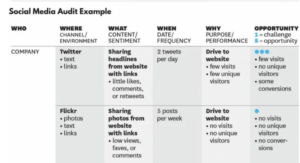Is it time to give your brand’s social media strategy a much-needed checkup? In the ever-evolving landscape of social media, relying on intuition alone is no longer enough. It’s crucial to base your strategies on solid data and clear objectives. After all, accountability is key, and you shouldn’t be left wondering about the impact of your social media efforts.

The dilemma many companies face is their tendency to navigate the social media sphere without a well-defined plan. It happens – perhaps you’ve inherited a social presence that was previously adrift, or simply haven’t had the opportunity to scrutinize your digital footprint. Regardless of the reason, conducting a social media audit is a savvy move.
The good news? It doesn’t have to be a time-consuming ordeal, especially if you take advantage of our free and user-friendly social media audit template. In the following sections, we’ll walk you through the efficient process of conducting a social media audit. For a more comprehensive breakdown, check out the accompanying video.
Social Media audit:
- What Exactly Is a Social Media Audit?
- The Benefits of a Social Media Audit
- Maximizing Your Social Media Audit Template
But first, let’s clarify what a social media audit entails.
1.What Exactly Is a Social Media Audit?
A social media audit involves a thorough evaluation of your business’s social media presence, delving into performance metrics and identifying opportunities for growth and optimization. These audits are indispensable for several reasons:

- Understanding Impact: Audits shed light on how your social media presence aligns with your company’s objectives.
- Engaging Effectively: They help you consistently engage with your audience and provide quality customer care.
- Discovering Opportunities: Audits uncover new business prospects and innovative ways to enhance your brand’s visibility.
Now, you might wonder if conducting an audit is genuinely worth your time and effort, given your already hectic schedule. The answer is a resounding “yes,” especially when you streamline the process with our template. Before we delve into the nitty-gritty of auditing, let’s explore some of its compelling advantages:
2.The Benefits of a Social Media Audit

- Informed Decision-Making: Audits provide concrete answers to pressing questions like, “Do we need to be on TikTok?” or “Why invest so much time in LinkedIn with minimal engagement?” Backed by performance data, audits prevent impulsive decisions and equip you to pivot wisely in the rapidly evolving social media landscape.
- Highlighting Business Impact: Marketing departments often face scrutiny regarding social media ROI. Audits become indispensable for showcasing wins that might have otherwise slipped under the radar. These wins could include significant interactions, follower surges, or viral content, all of which are made apparent through comprehensive reporting.
- Time Savings: In the long run, audits save significant time. By identifying and eliminating low-priority tasks and assessing opportunities for growth, you can adjust your priorities efficiently. Knowing what works and what doesn’t is a time-saver par excellence.
Now, let’s dive into how to use our social media audit template to enhance your strategy.
3.Maximizing Your Social Media Audit Template
 Don’t let the term “audit” intimidate you. Our template simplifies the process – you just need to plug in your data. If you’re already utilizing an analytics tool like Sprout, pinpointing your key audit metrics becomes a breeze.
Don’t let the term “audit” intimidate you. Our template simplifies the process – you just need to plug in your data. If you’re already utilizing an analytics tool like Sprout, pinpointing your key audit metrics becomes a breeze.
We understand that every brand has unique priorities. Feel free to tailor your social media audit template according to your specific needs. Ensure that it includes the following elements:
- Profile Information (Name and URL)
- Engagement Metrics
- Publishing Metrics
- Audience Demographics
- Referral Traffic
- Channel-Specific Metrics
For each metric, include the percentage change from the previous month or year. Year-over-year metrics accommodate seasonal fluctuations, such as the surge in social media activity during holidays, which can skew month-over-month metrics.
When in doubt, conduct your social media audits monthly or quarterly. This strikes a balance between tracking overarching trends and making timely adjustments.
Do you want to know about the 10 steps to create a social media audit? Because we have this guide! Go ahead and get it right now!
Mastering Social Media Audits: A Strategic Roadmap for Success
If you’re feeling overwhelmed about how to perform a social media audit, don’t fret. It might seem like a substantial undertaking initially, but the groundwork you lay now will be enlightening and save you considerable time down the road. Here’s a step-by-step breakdown for your first audit, which you can easily replicate for future assessments:

- Gather All Your Social Media Profiles: Start by taking inventory of your social profiles, even the ones on less prominent networks. Ensure that you have control over all accounts associated with your brand.
- Define Network-Specific Goals: Specify your social media objectives for each active platform, such as brand awareness, lead generation, community engagement, audience growth, or website traffic. Your goals will shape your presence on each platform and guide your metric selection.
- Ensure Consistent Branding: Check that your brand’s identity, including bio and “About” language, profile and banner images, destination URLs, and hashtags, remains consistent across all social profiles.
- Access Social Media Analytics: Dive into your data to gauge whether you’re meeting your objectives and pinpoint areas for improvement.
- Identify Top-Performing Posts: Analyze individual posts to uncover the content that resonates most with your audience, considering metrics like impressions, engagements, and reach.
- Track Social Media Traffic to Your Website: Establish the link between your social presence and website traffic to determine which posts generate genuine interest and which channels are most effective for lead generation.
- Explore Demographic Data: Understand your audience demographics, as they influence your content and messaging. Ensure consistency across platforms, and adjust your strategy for outliers.

- Assess New Platform Opportunities: Keep an eye on emerging social media platforms. Being an early adopter can yield significant advantages, as seen with TikTok’s rapid ascent.
- Set New Goals and Action Items: With your spreadsheet mostly filled out, it’s time to plan for the future. Define new objectives and actionable steps based on your findings.
- Share Your Audit with Your Team: Social media should be integrated into your overall business strategy. Share your audit results with your team to garner support, develop tailored content, and align your social presence with other departments, such as sales.
In summary, a social media audit is a powerful tool to ensure your brand remains relevant and effective in the digital landscape. By using our template and following these steps, you can streamline the process, make data-driven decisions, and propel your brand’s social media strategy forward. Remember, the value of social media reporting is an ongoing process, not a one-time endeavor.
Author
-

Harry is an associate in strategy and operations at AdClickAgency. His experience also includes team management in acquisition marketing at AdClickAgency and event operations for the Boston Red Sox. Harry is experienced in commercial operations, marketing, and growth and holds an MBA from The Tuck School of Business at Dartmouth. He is also one of the founding members of the AdClickAgency Blog, and he loves creating educational content for marketers – check out AdClickAgency Academy's video course on SEO that he produced alongside SEO expert Matthew Howells-Barby.
View all posts






